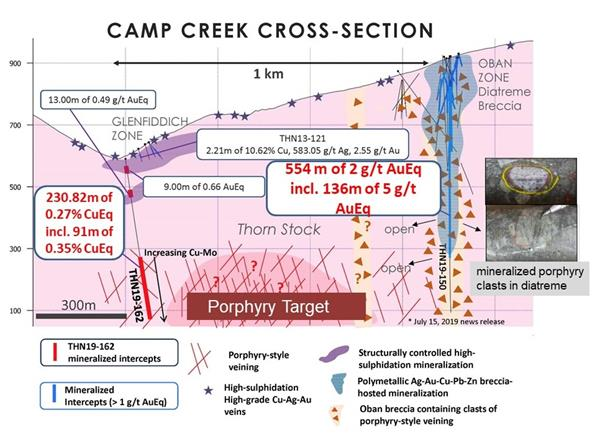Jun 12 2020
Brixton Metals Corporation has reported commencement of the exploration program for this year at its 100%-owned Thorn Project, situated in the Golden Triangle of British Columbia.
 Camp creek porphyry target cross-section. Image Credit: Brixton Metals Corporation.
Camp creek porphyry target cross-section. Image Credit: Brixton Metals Corporation.
Brixton compiled 154 assessment reports during the winter months to cover the mineral claims that it recently acquired. Moreover, the company employed Fathom Geophysics to obtain and process property-wide ASTER and SENTINEL-2 satellite data for alteration minerals.
Highlights of Winter Data Mining
- New assays acquired for 3,240 rock, 10,524 soils, and 486 silts from historic assessment reports within the 2,300 km2 claim block
- The newly obtained data led to four new, high-priority exploration areas for copper and gold, which will be a crucial focus for 2020
We are excited to begin the exploration season at the giant Thorn Project. We will continue to advance exploration on the Camp Creek blind porphyry target and the Outlaw sediment host gold target in preparation for drilling later this summer. The newly identified target areas combined with the known targets support our district scale mining camp in the making thesis.
Gary R. Thompson, Chairman and CEO, Brixton Metals Corporation
Camp Creek Porphyry Target
The strategy is to perform 9 line kilometers of Induced Polarization (IP) geophysics across the Camp Creek blind porphyry target, which includes downhole IP of holes 150 (depth of 829 m) and 162 (depth of 554 m), where porphyry-style mineralization was encountered during the 2019 drilling. Both these holes are situated nearly 1 km apart.
Plan for the additional exploration is as follows:
- A ground radiometric survey across the Camp Creek target
- Four acid geochemistry analysis in the Camp Creek area on chosen historically drilled core
- Collection of new rock samples along La Jaune Creek at 100 m stations and along Camp Creek at 50 m stations
Brixton Metals will identify future drill targets once the above new results are integrated.
Outlaw Sediment Hosted Gold Target
To prepare for drilling at the Outlaw West area, Brixton Metals plans to acquire additional infill soil at 50 m x 50 m stations and further rock samples from the showings in which the 2018 rock grab samples yielded up to 39 g/t Au.
New Copper-Gold Targets
Brixton Metals employed Fathom Geophysics over the winter months to collect and process property-wide ASTER and SENTINEL-2 satellite data for the mapping of alteration minerals.
Processing of ASTER satellite data was performed to highlight prospective alteration of chlorite, epidote, alunite, kaolinite, muscovite, dickite, and pyrophyllite. Data from the SENTINEL-2 satellite was processed to map alteration of kaolinite, jarosite, and goethite. These processes have successfully highlighted various areas of coincidental sophisticated jarosite and argillic anomalies.
By processing the data mining and remote sensing data, Brixton Metals could determine four new, high-priority areas of interest.
As part of its 2020 summer exploration campaign, the company plans to perform geological mapping and prospecting together with soil-rock geochemistry to collect up to 10,000 samples. Moreover, a survey of chosen areas will be performed using ground-based radiometric with a backpack unit to support potassic alteration mapping.
COVID Management Plan
In British Columbia, Brixton Metals follows WorkSafe BC Guidelines, apart from recommendations and orders issued by the Provincial Health Officer, the Office of the Chief Inspector of Mines and First Nations Governments, local communities, and stakeholders.